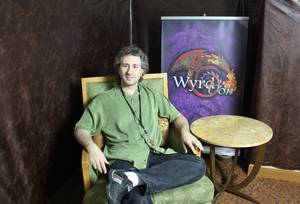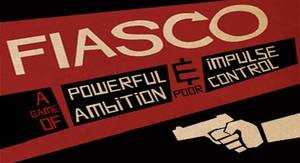Future Now
The IFTF Blog
Wyrd Con, Where Futures Come Alive
Walk into the Hilton Costa Mesa in Los Angeles on the weekend of Wyrd Con, and you would never know from the cool and elegant lobby that down in the basement wars are raging, virgin peaks are being climbed, dystopian future governments are holding prisoners hostage, and adventurers are climbing through an actual three story maze built in one of the conference rooms. Wyrd Con, the transmedia storytelling convention, is in town.
A professional convention for transmedia storytellers, Wyrd Con focuses on the tools and tricks of storytelling. Creator Ira Ham explains, "It's where you see the cheese get made."

Ham crowdfunded over $20,000 to make Wyrd Con IV a reality, and over the past 3 years, the community expanded to include everyone from die hard live action role playing "LARPers" to thought leaders in the storytelling industry and academic field.
A story is typically known as linear, with a clear beginning, middle and end. The reader is passive, they can't interact with the story or alter the outcome. In transmedia stories, the reader is frequently an active participant, and the narratives unfold over many platforms, sometimes with digital media, but often via a more bodily experience. The result is immersive—the reader is co-creator, and the story is felt.
Wyrd Con focused on how these kinds of stories can be told, and how the storytellers build these story worlds. What are the tools in a storyteller's toolbox? So far the focus includes transmedia, alternate reality, table top, live action and traditional bard storytelling (like NASA commissioned for their 50th anniversary).
These tools—how we communicate the story, "media"—are rather more pervasive than is commonly perceived, as Marshal McLuhan often argues. Technologies encompassed by this wider view of media and storytelling knot together some surprisingly disparate objects, practices, techniques and knowledge.
Representing the USC Annenberg Innovation Lab, Erin Reilly and Geoffrey Long presented their academic research in transmedia and new media in terms of childhood education. Collaborating with The Alchemists Transmedia Storytelling Company and author David Wiesner, the Annenberg Innovation Lab expanded the wordless picture book Flotsam into "a transmedia play experience" through what they call "Think and Do" workshops. Erin Reilly explains the project here.
Giving the Social Inventor's Toolkit to Jeff Gomez, CEO of Starlight Runner Entertainment, he shared with me his transmedia campaigns for governments like Columbia that got stories out in ways people could engage with. Beginning as a young Dungeon Master in Manhattan, he's since created participatory narratives and world built for stories like James Cameron's Avatar, Microsoft's Halo, and Hot Wheels, in addition to his geopolitical work.

Costumed as an Artifact from the Future with Jeff Gomez
Attending to the micro-elements of the story as well as the macro, I even foregrounded language and approached it as a worldbuilding tool with David Peterson, president of the Language Creation Society. In his workshop he helped us create words and rudimentary grammar from a minimal sound system. Previously, he worked as a language consultant on the Game of Thrones television show to expand the fictional language Dothraki, described in the books, into a fleshed out vernacular.
 Tabletop was the newest edition to the Wyrd Con toolbox with Jason Morningstar as the honored guest designer. Creator of table top narratives like Fiasco, he discussed roleplaying experience design—curating what he called "the fruitful void," a creative tension between players which goes beyond statistics, and "bleed," when a character and the "real self" experience emotional resonance. Atomizing authority in his role playing experiences, he democratizes the mechanics of the "game master" role in tabletop and live action role playing games. His productions are "game master-less."
Tabletop was the newest edition to the Wyrd Con toolbox with Jason Morningstar as the honored guest designer. Creator of table top narratives like Fiasco, he discussed roleplaying experience design—curating what he called "the fruitful void," a creative tension between players which goes beyond statistics, and "bleed," when a character and the "real self" experience emotional resonance. Atomizing authority in his role playing experiences, he democratizes the mechanics of the "game master" role in tabletop and live action role playing games. His productions are "game master-less."
Live action role playing (LARP) was well represented. The first night of the convention, I played an underground Nordic LARP game called "Prison," set in the last years of the 21st century. With a two page scenario overview, and a few specific details about each of our characters, we had control as players over a large part of world history, and our individual stories. Sitting in a dark room with about 12 other prisoners, we improvised, wove together a history of the last half of the 21st century from our conversations, and even got emotional, seemingly distant yet extremely intimate, experiencing character "bleed."
Representing the Institute for the Future, my talk at Wyrd Con (online soon) focused on these cultural media, and how our stories affect our worldview and self perception. I discussed the work of futurists who use the tools of storytelling to design the same kind of immersive experiences game creators and LARPers do. Far from predicting "the future" with dry statistics, we use our imagination to explore possible futures through storytelling. Ultimately, these simulations (different scenarios of the future) help participants, clients and partners imagine better their preferred futures, and guide insightful decisions in the present.
One way the Institute for the Future uses transmedia storytelling to create immersive experiences is by designing artifacts from the future. Moving from the imagination to something tangible and concrete, these artifacts prototype a possible future. We study them as we study archeological remains, provoking dialogue about everyday life in these possible future scenarios.
Wearing some rather flamboyant fashion artifacts from 2030, my outfit is the Conscious Collection taken to the next level. Picking up on trends like Adam Harvey's Stealth Wear, and inspired by Forum for the Future's project Fashion Futures 2025, the artifacts focus on climate change, energy and security issues. The faux-leather covered rebreather protects me from the harsh airborne particles, and my hat and cape not only produce personal energy, but protect against radiation and act as counter-surveillance thermal signal reduction. Just a couple weeks after wearing these artifacts, Victoria and Albert Museum of Design hosted a climate fashion hackathon with the London School of Fashion for the 2013 London Design Festival.
By experiencing this possible future, the story came alive — people began to consider what they would wear if they wanted to produce their own energy, protect themselves against a worsening climate or avoid geothermal imaging. At Wyrd Con, the people I met were eager to dive into the details of the story, and in turn contemplate their future in a useful way.
"Wyrd" is particularly apt in this case, as it refers to one's fate or personal destiny in Old English. Whether discussing wearable tech and leather with LARPers, building Caine-inspired cardboard structures, conducting a bank heist, or in prison debating world politics in the year 2100 Wyrd Con is a celebration of stories that invite anyone to explore where their own wyrd could lead.



